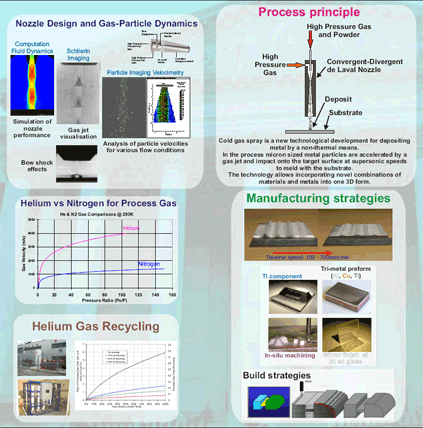Dr Bill O'Neill is making components by firing material at over 2000mph. The particles slam onto a substrate to form a dense, stable structure at relatively low temperatures.
Cold Gas Dynamic Manufacturing
Innovative Manufacturing Research Centre (IMRC) Department of Engineering
For component manufacture, or for modification and repair purposes, many industries are interested in creating components additively, by depositing dense layers of powdered metals. However, the high temperatures currently employed to melt the metal particles can undermine the integrity and stability of the resulting material. 'Cold gas dynamic spraying' offers an alternative, 'non-melt' approach.
Deficiencies of existing processes
Adding one metal to another metal presents a challenge which existing techniques are not well equipped to meet. Conventional spraying of powdered metals requires high temperatures and offers insufficient control, while welding causes a high degree of thermal distortion. Cladding one metal with another with the use of lasers is associated with a high degree of distortion, cracking (in certain material systems) and loss of control over the deposited material geometry and microstructure. Despite this, it is currently the method of choice within commercial additive manufacturing systems. Many of the problems associated with existing techniques are caused by the high temperatures needed to melt the raw materials - up to 2000°C. A technology capable of joining layers of different types of metal and other materials at low temperatures would offer considerable advantages.
Cold Gas Dynamic Spraying
In principle, cold gas dynamic spraying (CGDS) should offer these capabilities. CGDS involves high-pressure, high-flow rate gas, heated to relatively low temperatures (150°-300°C). By using a converging/diverging nozzle, the gas stream - and any powder within it - is accelerated to velocities in excess of 500-1000m per second. As the particles hit the target surface, they impact and consolidate, producing localised forge bonding. The metallic coatings produced have a very low porosity and are unaffected by phase changes associated with high-temperatures. CGDS has many other advantages. It can process a broad range of metals - e.g. copper, aluminium, aluminium MMC, titanium alloys and stainless steels, and it is possible to vary the thickness of the layers between a few microns and several thousand microns depending on the traverse speeds used. While the deposition rate for conventional processes ranges from 0.5-2.0kg per hour, CGDS is expected to achieve deposition rates of 5-30kg per hour, depending on the materials involved and the available gas supplies.
The Advantages of CGDM:
- High material density
- Minimal thermal input to substrate
- Low oxide content
- Highly wrought microstructure
- Phase and compositional stability
- Low residual stress
- Good surface finish
- High deposition efficiency
- Minimal grain growth (possible to maintain nano-crystalline structures)
- Low capital & operating costs (compared with laser)
- Controllable, focussed "beam" of material
- Powder feedstock can be mixed and graded to functionally graded materials.
- Deposition onto and/or build with dissimilar materials and alloys.
From this it can be appreciated that CGDS could be an ideal basis for a component manufacturing process, and thus cold gas dynamic manufacturing (CGDM).
Research Aim
The aim is to develop a system for the manufacture of metallic components by supersonic cold deposition of polymer, metal and ceramic powders.
Project Schedule
- Establish 'Cold Spray' capability.
- Transition to solid free form, system integration.
- Demonstrate industrial applicability and pursue collaborative partnerships.

The experimental CGDM apparatus which has been developed in-house could work with helium, nitrogen or even dry air, but IMRC has chosen to work with helium since the sonic speed is two times faster and thus gives particles increased kinetic energy resulting in greater plastic deformation on impact, and improved material consolidation.
The research
The primary test material is aluminium, as it is particularly difficult to process by laser. The aim is to develop a good understanding of the mechanics of the deposition process, and to evaluate the qualities and handling aspects of the materials that are produced, comparing them to the bulk material in its wrought and cast forms. Apart from that IMRC will be identifying a range of alloys that are difficult to process - for instance, nickel-based superalloys, and subjecting them to the same analyses. The aim is to explore the potential for in-situ manufacture of a range of metal based components.
Helium recycling facility
The best results in CGDM are achieved using helium as the process gas, however, the cost of helium makes its use prohibitive from a commercial perspective. At Cambridge we are working with BOC to develop and evaluate the potential of helium recovery and recycle for the process. BOC have developed and installed a system that can capture, purify and compress the process gas stream ready to spray again. The system is fully flexible and configurable, and the process operation is independent of gas input purity levels. It is anticipated that recovery efficiencies in excess of 85% will be achieved in component manufacture making the use of helium a cost effective alternative to nitrogen. We believe this to be the only facility of this type globally.
Applications
CGDS coatings have been successfully applied commercially to the attachment of heat sinks and condensers, and aluminium grounding strips. At present, Dr. Bill O'Neill is setting up a special interest group for manufacturers from a range of sectors that could benefit from this new technology. CGDM is very exciting: it could potentially solve material compatibility problems associated with the manufacture of graded alloy structures. It could also revolutionise the 'metal on' mould tool modification and repair industry and the turbine component repair industry. The IMRC team are currently developing a range of applications for the automotive, aerospace and biomedical sectors.
Contact:
Dr Bill O'Neill
University of Cambridge
Institute for Manufacturing
Department of Engineering
Mill Lane, Cambridge CB2 1RX, UK
Phone: +44 (0)1223 766880
Fax: +44 (0)1223 766400
E-mail: wo207@eng.cam.ac.uk

